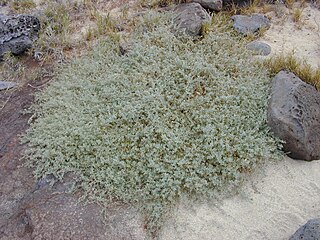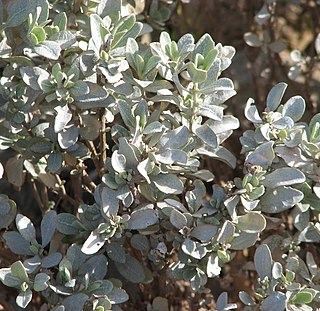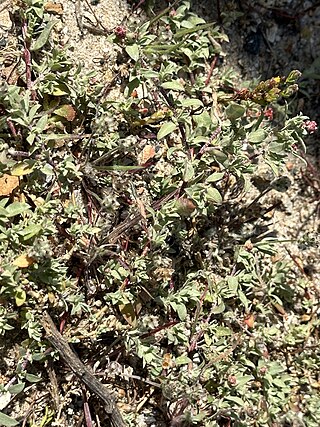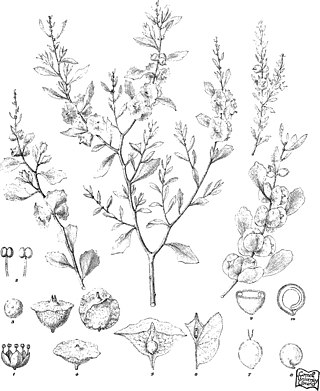
Atriplex semibaccata, commonly known as Australian saltbush, berry saltbush, or creeping saltbush, is a species of flowering plant in the family Amaranthaceae and is endemic to Australia. It is a perennial herb native to Western Australia, South Australia, Queensland and New South Wales, but has been introduced into other states and to overseas countries. It flowers and fruits in spring, and propagates from seed when the fruit splits open. This species of saltbush is adapted to inconsistent rainfall, temperature and humidity extremes and to poor soil. It is used for rehabilitation, medicine, as a cover crop and for fodder. Its introduction to other countries has had an environmental and economic impact on them.

Atriplex hymenelytra, the desert holly, is silvery-whitish-gray shrub in the family Amaranthaceae, native to deserts of the southwestern United States. It is the most drought tolerant saltbush in North America. It can tolerate the hottest and driest sites in Death Valley, and remains active most of the year.

Fritillaria striata, the striped adobe lily, is an uncommon species of fritillary.

Atriplex vesicaria, commonly known as bladder saltbush, is a species of flowering plant of the family Amaranthaceae and is endemic to arid and semi-arid inland regions of Australia. It is an upright or sprawling shrub with scaly leaves and separate male and female plants, the fruit often with a bladder-like appendage.
Horkelia tularensis is a species of flowering plant in the rose family known by the common name Kern Plateau horkelia. It is endemic to Tulare County, California, where it is known from about ten occurrences in the High Sierra Nevada. It grows in rocky, exposed areas.
Atriplex cordulata is a species of saltbush known by the common names heartscale and heart-leaf orache. It is endemic to the Central Valley and its San Joaquin Valley of California, where it grows in areas of saline and alkaline soils.

Atriplex coronata is a species of saltbush known by the common name crownscale. It is endemic to California.

Atriplex coulteri is a species of saltbush known by the common names Coulter's saltbush and Coulter's orache.
Atriplex depressa is a species of saltbush known by the common names brittlescale and depressed orache. It is sometimes treated as a variety of Atriplex parishii.
Atriplex fruticulosa is a species of saltbush known by the common names ball saltbush and little oak orach.

Atriplex lentiformis is a species of saltbush.

Atriplex lindleyi is a species of saltbush known by the common name Lindley's saltbush. It is native to Australia, where it is widespread, especially in dry areas. It is known elsewhere as an introduced species, in California and the United States an invasive species.
Atriplex parishii is an uncommon species of saltbush known by the common names Parish's saltbush and Parish's brittlescale. It is native to central and southern California where it can occasionally be found along the immediate coastline, and the Channel Islands. Its distribution extended historically into the western edges of the Mojave Desert and Baja California and it may still exist there.
Atriplex phyllostegia is a species of saltbush known by the common names arrowscale, leafcover saltweed, and Truckee orach. It is native to the western United States from California to Utah, where it grows in meadow bottoms and areas with saline soils such as dry or ephemeral lakes.
Atriplex spinifera is a species of saltbush, known by the common names spiny saltbush and spinescale saltbush.
Atriplex truncata is a species of saltbush known by the common names wedgeleaf saltbush, wedgescale, and wedge orach, native to western North America from British Columbia to California and to New Mexico. It grows in montane to desert habitats with saline soils, such as dry lake beds.

Atriplex watsonii is a species of saltbush known by the common name Watson's saltbush, or Watson's orach. It is native to the coastline of California and Baja California, where it grows in coastal areas with saline soils, such as salt marshes and beach scrub, with other halophytes such as saltgrass. It extends inland in the Los Angeles Basin, and along the Santa Ana River.

Nitrophila mohavensis is a rare species of flowering plant in the family Amaranthaceae known by the common name Amargosa niterwort. It is endemic to Nye County in southwestern Nevada and Inyo County, in eastern California.

Streptanthus albidus is a species of flowering plant in the mustard family known by the common name Metcalf Canyon jewelflower. It is endemic to California, where it is known only from the Central Coast Ranges and San Francisco Bay Area. It grows in open areas such as grasslands, often on serpentine soils.

Atriplex stipitata, commonly known as mallee saltbush, bitter saltbush and kidney saltbush, is a species of shrub in the family Amaranthaceae, found in all mainland states of Australia.











